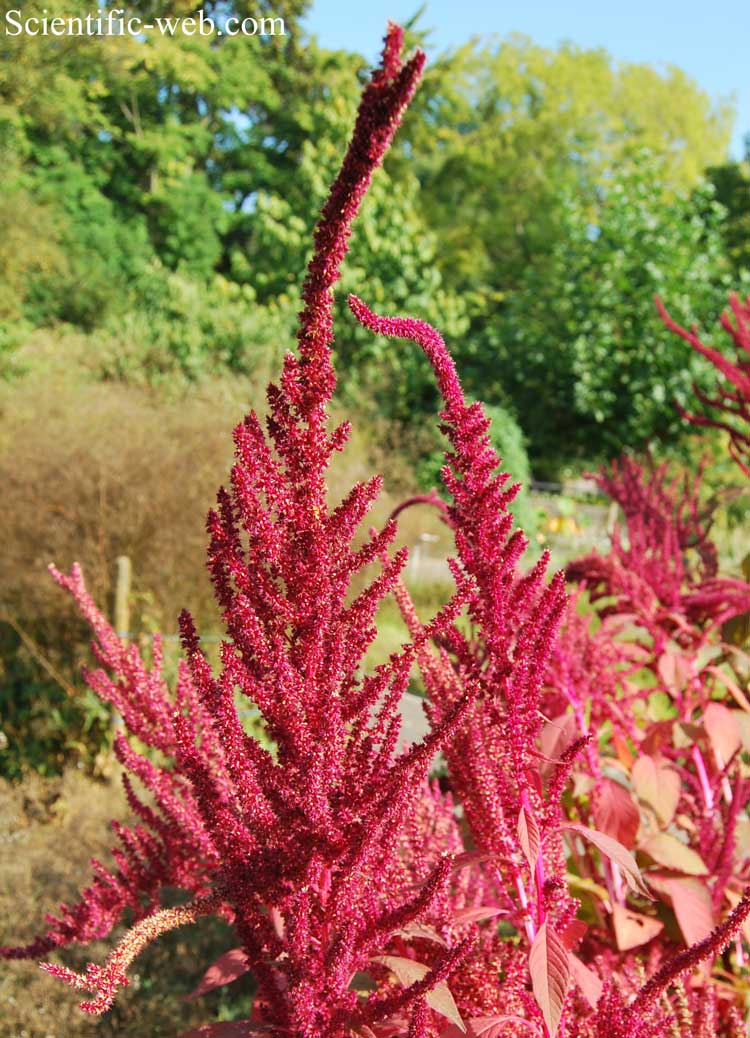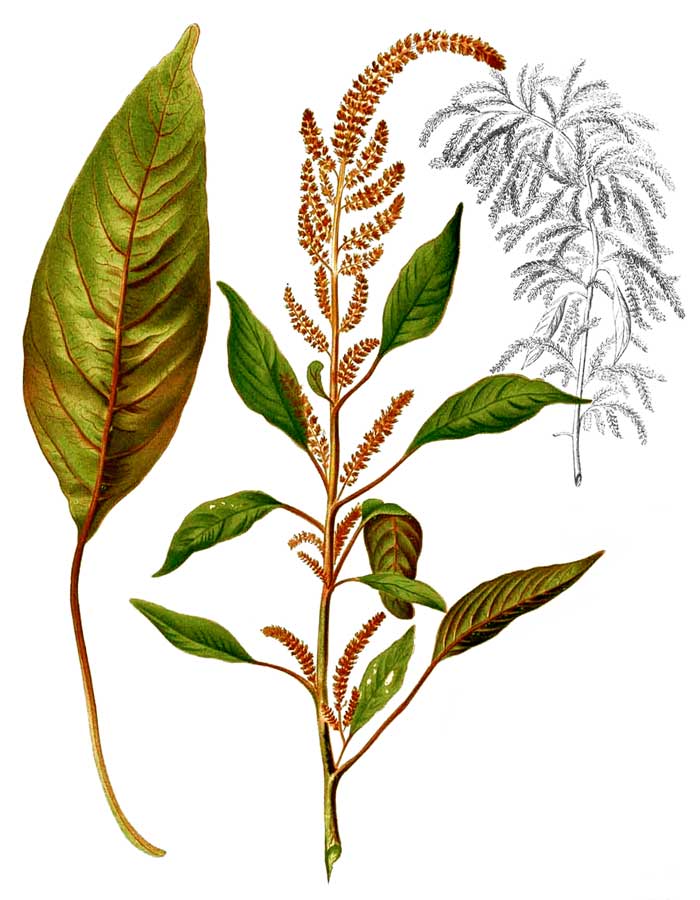
Amaranthus cruentus, Photo: Michael Lahanas
Classification System: APG IV
Superregnum: Eukaryota
Regnum: Plantae
Cladus: Angiosperms
Cladus: Eudicots
Cladus: Core eudicots
Ordo: Caryophyllales
Familia: Amaranthaceae s.l.
Cladus: Amaranthaceae s.str.
Subfamilia: Amaranthoideae
Genus: Amaranthus
Species: Amaranthus cruentus
Name
Amaranthus cruentus L., Syst. Nat., ed. 10. 2: 1269. (1759)
Synonyms
Homotypic
Amaranthus paniculatus var. cruentus (L.) Moq., Prodr. [A. P. de Candolle] 13(2): 257. (1849)
Amaranthus hybridus subsp. cruentus (L.) Thell., Fl. Advent. Montpellier 205. (1912)
Amaranthus hybridus var. cruentus (L.) Mansf., Kulturpflanze 2: 54. (1959)
Heterotypic (ref. Hassler 2019)
Amaranthus aureus Besser, Cat. Hort. Volhyn. (1816) 8.
Amaranthus bernhardi hort. ex Moq., Prodr. [A. P. de Candolle] 13(2): 258. (1849), nom. inval. in syn.
Amaranthus caudatus f. oblongopetalus Suess.
Amaranthus caudatus var. pseudopaniculatus Suess.
Amaranthus chlorostachys Willd., Hist. Amaranth. 34 (t. 10, fig. 19) (1790).
Amaranthus cruentus var. albus Saubhik Das, Nordic J. Bot. 30(4): 418 (2012).
Amaranthus dussii Sprenger, Bull. R. Soc. Tosc. Ort 21: 178 (1896).
Amaranthus flavus L., Syst. Nat., ed. 10. 2: 1269 (1759).
Amaranthus frumentaceus Buch.-Ham., Fl. Ind. (Roxburgh) 3: 699 (1832).
Amaranthus hybridus Vell., Fl. Flumin. Icon. 10: t. 28 (1831), nom. illeg. (later homonym of Amaranthus hybridus L., 1753).
Amaranthus hybridus subsp. incurvatus (Timeroy ex Gren. & Godr.) Brenan, Watsonia 4 (1957).
Amaranthus hypochondriacus var. subdubius Suess.
Amaranthus laxiflorus Comell. ex Pollini, Fl. Veron. iii. 114 (1824).
Amaranthus paniculatus L., Sp. Pl., ed. 2. 2: 1406 (1763).
Amaranthus cruentus var. paniculatus (L.) Thell.
Amaranthus hybridus var. paniculatus (L.) Thell., Fl. Advent. Montpellier 205 (1912).
Amaranthus hybridus subsp. paniculatus (L.) Heijný, in Dostál: Květena ČSR 444. (1950).
Amaranthus patulus Bertol., Comment. Itin. Neapol. 171, t. 12 (1837).
Amaranthus cruentus var. patulus (Bertol.) Lambinon, Bull. Jard. Bot. Natl. Belg. 47(1-2): 247 (1977).
Amaranthus hybridus subsp. patulus (Bertol.) Carretero, Collect. Bot. (Barcelona) 11: 127 (1979).
Amaranthus hybridus var. patulus (Bertol.) Thell., Fl. Advent. Montpellier 206. (1912).
Galliaria patula (Bertol.) Bubani, Fl. Pyren. (Bubani) 1: 187 (1897).
Amaranthus spicatus Rchb., Fl. Germ. Excurs. 585. (1832) (later homonym of Amaranthus spicatus Lam., 1779).
Amaranthus timeroyi Jord. ex Moq., Prodr. [A. P. de Candolle] 13(2): 259 (1849), nom. inval. in syn.
Amaranthus trivialis Rota, Giorn. Bot. Ital. ii. II; 287. (1846)
Homonyms
Amaranthus cruentus Willd. ex Roxb., Fl. Ind. 3: 610. (1832), nom. illeg. = synonym of Amaranthus caudatus L.
Distribution
Native distribution areas:
Northern America
Mexico
Mexico Central, Mexico Gulf, Mexico Southeast, Mexico Southwest
Southern America
Central America
El Salvador, Guatemala, Honduras, Nicaragua, Panamá
widely naturalized, cosmopolitan.
References: Brummitt, R.K. 2001. TDWG – World Geographical Scheme for Recording Plant Distributions, 2nd Edition

Amaranthus cruentus
References
Linnaeus, C. 1759. Systema naturae per regna tria naturae, secundum classes, ordines, genera, species, cum characteribus, differentiis, synonymis, locis. Tomus II. Editio decima, reformata. Pp. [I–VI], 825–1384. Impensis direct. Laurentii Salvii, Holmiae [Stockholm]. BHL Reference page. : 1269.
Moquin-Tandon, A. 1849. Amarantaceae. In: De Candolle, A.P. (ed.): Prodromus systematis naturalis regni vegetabilis 13(2): 231–424. Masson, Paris. BHL. Reference page. : 257
Thellung, A. 1912. La flore adventice de Montpellier. Mémoires de la Société des Sciences Naturelles de Cherbourg 38: 57–728. BHL Reference page. : 205
Additional references
eFloras 2008. Amaranthus cruentus in Flora of North America . Missouri Botanical Garden, St. Louis, MO & Harvard University Herbaria, Cambridge, MA.
Links
Govaerts, R. et al. 2019. Amaranthus cruentus in Kew Science Plants of the World online. The Board of Trustees of the Royal Botanic Gardens, Kew. Published online. Accessed: 2019 Aug. 13. Reference page.
Hassler, M. 2019. Amaranthus cruentus. World Plants: Synonymic Checklists of the Vascular Plants of the World In: Roskovh, Y., Abucay, L., Orrell, T., Nicolson, D., Bailly, N., Kirk, P., Bourgoin, T., DeWalt, R.E., Decock, W., De Wever, A., Nieukerken, E. van, Zarucchi, J. & Penev, L., eds. 2019. Species 2000 & ITIS Catalogue of Life. Published online. Accessed: 2019 Aug. 13. Reference page.
International Plant Names Index. 2019. Amaranthus cruentus. Published online. Accessed: Aug. 13 2019.
Tropicos.org 2019. Amaranthus cruentus. Missouri Botanical Garden. Published online. Accessed: 13 Aug. 2019.
Vernacular names
Deutsch: Rispen-Fuchsschwanz
English: Purple Amaranth, Red Amaranth, Mexican Grain Amaranth
español: Huautli, Alegría
suomi: Purppurarevonhäntä
français: Amarante Rouge
hornjoserbsce: Wisaty šćěrjenc
日本語: スギモリゲイトウ
lietuvių: Šluotinis burnotis
polski: Szarłat wyniosły
svenska: Blodamarant
Amaranthus cruentus is a flowering plant species that yields the nutritious staple amaranth grain. It is one of three Amaranthus species cultivated as a grain source, the other two being Amaranthus hypochondriacus and Amaranthus caudatus. In Mexico, it is called huautli (Spanish pronunciation: [ˈwawtli] and alegría ([aleˈɣɾi.a] and in English it has several common names, including blood amaranth, red amaranth, purple amaranth,[2] prince's feather, and Mexican grain amaranth. In Maharashtra, it is called shravani maath ("श्रावणी माठ") or rajgira ("राजगिरा"). In Kerala, it is called chuvanna cheera ("ചുവന്ന ചീര") or commonly, cheera ("ചീര").In Karnataka, it is called "Dantina soppu"("ದಂಟಿನ ಸೊಪ್ಪು") or harive soppu ("ಹರಿವೆ ಸೊಪ್ಪು").
Description
Amaranthus cruentus is a tall annual herb topped with clusters of dark pink flowers. The plant can grow up to 2 m (6 ft) in height, and blooms in summer to fall. It is believed to have originated from Amaranthus hybridus, with which it shares many morphological features. The plant is usually green in color, but a purple variant was once grown for use in Inca rituals. height up to 13 feet are found in Wayanad, Kerala.
Uses
This section needs additional citations for verification. Please help improve this article by adding citations to reliable sources. Unsourced material may be challenged and removed. (June 2021) (Learn how and when to remove this template message)
This species was in use as a food source in North America and Central America as early as 4000 BC. The seeds are eaten as a cereal grain. They are black in the wild plant, and white in the domesticated form. They are ground into flour, popped like popcorn, cooked into a porridge, or made into a confectionery called alegría.[3] The leaves can be cooked like spinach, and the seeds can be germinated into nutritious sprouts. While A. cruentus is no longer a staple food in North and Central America, it is still grown and sold as a health food.
It is an important crop for subsistence farmers in Africa.[4]
In Maharashtra, during month of Shravan, a stir-fried vegetable with just grated coconut is served during festivals. The stem is used in curry made with vaal hyacinth bean.
Among the Zuni people, the feathery part of plant ground into a fine meal and used to color ceremonial bread red.[5] The crushed leaves and blossoms are also moistened and rubbed on cheeks as rouge.[6]
In Kinnaur District of Himachal Pradesh (India) the grain is used to make kheer and served mostly as dessert during marriage ceremony. The flour is also used to make deep fried chapatis (pole).
Cultivation
A. cruentus is cultivated as an ornamental plant, valued for its feather-like flowering plumes. It is usually grown from seed as a half-hardy annual, that is sown under glass in early Spring and planted out in summer. Numerous cultivars have been developed, of which the following have gained the Royal Horticultural Society's Award of Garden Merit:
'Autumn Palette Group'[7] (earth colours – rust, cream, brown)
'Oeschberg'[8] (crimson flowers)
'Velvet Curtains'[9] (deep red/crimson)
References
"Amaranthus cruentus". World Checklist of Selected Plant Families (WCSP). Royal Botanic Gardens, Kew – via The Plant List.
BSBI List 2007 (xls). Botanical Society of Britain and Ireland. Archived from the original (xls) on 2015-06-26. Retrieved 2014-10-17.
St. Clair, Kassia (2016). The Secret Lives of Colour. London: John Murray. p. 131. ISBN 9781473630819. OCLC 936144129.
Grubben, G.J.H. & Denton, O.A. (2004) Plant Resources of Tropical Africa 2. Vegetables. PROTA Foundation, Wageningen; Backhuys, Leiden; CTA, Wageningen.
Stevenson, Matilda Coxe 1915 Ethnobotany of the Zuni Indians. SI-BAE Annual Report #30 p.87
Stevenson, p.83
"Amaranthus cruentus 'Autumn Palette Group'". Royal Horticultural Society. Retrieved 5 January 2018.
"Amaranthus cruentus 'Oeschberg'". Royal Horticultural Society. Retrieved 5 January 2018.
"Amaranthus cruentus 'Velvet Curtains'". Royal Horticultural Society. Retrieved 5 January 2018.
Retrieved from "http://en.wikipedia.org/"
All text is available under the terms of the GNU Free Documentation License

